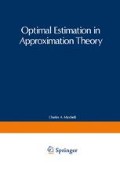Abstract
The transfer of information over noisy and dispersive media has traditionally been, and still represents, an important subject of applied estimation and approximation theory. In this paper the specific problems encountered in synchronous data-transmission systems are reviewed. A first set of problems arises in timing-and carrier-phase tracking and in adaptive equalization, where continuous-valued parameters are to be estimated which may change slowly over time. A second set of problems deals with recovering the transmitted information from received noisy signals. It is shown that in the presence of severe signal distortion and/or redundant sequence coding the optimum receiver has to solve a dynamic programming problem.
Access this chapter
Tax calculation will be finalised at checkout
Purchases are for personal use only
Preview
Unable to display preview. Download preview PDF.
References
H.L. Van Trees, Detection, Estimation and Modulation Theory, Parts I, II and III, New York: Wiley 1968, 1971.
W.R. Bennett and J.R. Davey, Data Transmission, New York: McGraw-Hill, 1965.
J.M. Wozencraft and I.M. Jacobs, Principles of Communications Engineering, New York: Wiley, 1965.
R.W. Lucky, J. Salz, and E.J. Weldon, Jr., Principles of Data Comrrrunicaton, New York: McGraw-Hill, 1968.
H. Kobayashi, “Simultaneous adaptive estimation and decision algorithm for carrier-modulated data-transmission systems,” IEEE Trans. Comrnun. Technol., vol. COM-19, pp. 268–280, June 1971.
G. Ungerboeck, “Adaptive maximum-likelihood receiver for carrier-modulated data-transmission systems,” IEEE Trans. Comrnun., vol. C0M-22, pp. 624–636, May 1974.
H. Robbins and S. Monro, “A stochastic approximation method,” Ann. Math. Stat., pp. 400–407, 1951.
K.H. Mueller and M. Mueller, “Timing recovery in digital synchronous data receivers,” IEEE Trans. Comrnun., vol. COM-24, pp. 516–530, May 1976.
D. Maiwald, “On the performance of decision-aided timing recovery,” IBM Research Report, RZ 749, December 1975.
L.E. Franks and J.P. Bubrouski, “Statistical properties of timing jitter in PAM timing recovery scheme,” IEEE Trans. Commun.3 vol. COM-22, pp. 913–920, July 1974.
D.L. Lyon, “Timing recovery in synchronous equalized data communication,” IEEE Trans. Communvol. COM-23, pp. 269–274, February 1975.
L.E. Franks, “Acquisition of carrier and timing data - I,” presentation at NATO Advanced Study Institute on New Directions in Signal Processing, in Communications and Control, Darlington, U.K., August 1974.
G. Ungerboeck, unpublished work.
P.A. Wirtz and E.J. Luecke, “Performance of optimum and suboptimum synchronizers,” IEEE Trans. Commun. Technol. vol. COM-17, pp. 380–389, June 1969.
A. Gersho, “Adaptive equalization of highly dispersive channels for data transmission,” Bell System Tech. vol. 48, pp. 55–70, January 1969.
K. Moehrmann, “Einige Verfahren zur adaptiven Einstellung von Entzerrern fur die schuelle Datemibertragung,” Nachrichten-technische Zeitsckriftj vol. 24, pp. 18–24, January 1971.
G. Ungerboeck, “Theory on the speed of convergence in adaptive equalizers for digital communications,” IBM J. Res. Develop.3 vol. 16, pp. 546–555, November 1972.
K.H. Mueller and D.A. Spaudling, “Cyclic equalization–A new rapidly converging adaptive equalization technique for synchronous data communication,” Bell System Tech. J. y vol. 54, pp. 369–406, February 1975.
G. Ungerboeck, “Fractional tap-spacing equalizer and consequences for clock recovery in data modems,” IEEE Trans. Commun.3 vol. COM-24, pp. 856–864, August 1976.
D. Godard, “Channel equalization using a Kalman filter for fast data transmission,” IBM J. Res. Develop. 3 vol. 18, pp. 267–273, May 1974.
A.P. Sage, Optimum Systems Controly Prentice-Hall, Englewood Cliffs, N.J., 1968.
R.D. Githin and F.R. Magee, Jr., work to be published.
P. Monsen, “Feedback equalization for fading dispersive channels,” IEEE Trans. Info. Theory, vol. IT-17, pp. 56–64, January 1971.
J. Salz, “Optimum mean-square decision-feedback equalization,” Bell System Tech. J., vol. 52, pp. 1341–1373, October 1973.
G.D. Forney, “Maximum-likelihood sequence estimation of digital sequences in the presence of intersymbol interference,” IEEE Trans. Info. Theory, vol. IT-18, pp. 363–378, May 1972.
R. Price, “Nonlinearly feedback-equalized PAM vs. capacity for noisy filter channels,” Conference Record ICC 1972, Philadelphia, pp. 22–12 /16, June 1972.
G.D. Forney, “The Viterbi algorithm,” Proc. IEEE, vol. 61, pp. 268–278, March 1973.
A.J. Viterbi, “Error bounds for convolutional codes and an asymptotically optimum decoding algorithm,” IEEE Trans. Info. Theory, vol. IT-13, pp. 260–69, April 1967.
A.J. Viterbi, “Convolutional codes and their performance in communication systems,” IEEE Trans. Commun. Technol., vol. C0M-19, pp. 751–772, October 1971.
Author information
Authors and Affiliations
Editor information
Editors and Affiliations
Rights and permissions
Copyright information
© 1977 Springer Science+Business Media New York
About this chapter
Cite this chapter
Ungerboeck, G. (1977). Estimation Problems in Data-Transmission Systems. In: Micchelli, C.A., Rivlin, T.J. (eds) Optimal Estimation in Approximation Theory. The IBM Research Symposia Series. Springer, Boston, MA. https://doi.org/10.1007/978-1-4684-2388-4_8
Download citation
DOI: https://doi.org/10.1007/978-1-4684-2388-4_8
Publisher Name: Springer, Boston, MA
Print ISBN: 978-1-4684-2390-7
Online ISBN: 978-1-4684-2388-4
eBook Packages: Springer Book Archive

